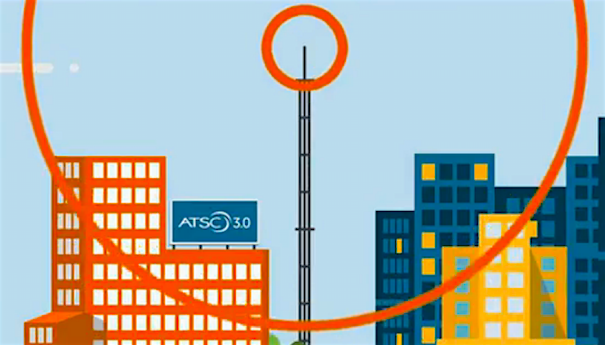Decoding the Mobile Broadcasting Landscape
Separating fact from fiction

As broadcasting technology evolves to potentially include sending broadcast TV signals to mobile devices, it’s important to understand the landscape from the terms being used, the systems being considered and the progress of technical development and adoption.
What is 5G Broadcast?
“5G Broadcast,” officially named “LTE-Based 5G Broadcast,” was developed by the Third Generation Partnership Program (3GPP). This global system is designed for cellular devices (e.g., phones) and is not being promoted as a solution for delivering content directly to television sets in the home. (Televisions could be reached through an intermediary device such as a set-top box or gateway device.)
5G Broadcast and its precursors were specified for operation in both cellular networks (typically with many small towers creating a dense network) and in traditional TV broadcast configurations (typically with fewer tall towers, each reaching a wider geographic area).
While not currently commercially deployed, 5G Broadcast is being eyed by TV broadcasters in several countries, including Europe. Cellphone operators, on the other hand, are not currently considering commercial adoption of 5G Broadcast that we are aware of.
Note that 5G Broadcast is different from 5G Multicast/Broadcast Service (5G NR MBS), also developed by 3GPP. 5G Broadcast is based on 4G LTE radio technology, whereas 5G MBS is based on 5G New Radio technology. 5G MBS is not being used for direct-to-consumer services but instead is finding its place in private networks for business use cases. Of course, this could change over time. 5G Broadcast, on the other hand, is being promoted as a potential direct-to-consumer service.
What is ATSC 3.0, and can it be used for mobile broadcasting?
ATSC 3.0, developed by ATSC, the Broadcast Standards Association, is an international next-generation broadcasting standard designed for robust transmission of IP bits over-the-air to televisions, cellular phones, moving vehicles and other devices.
Currently, ATSC 3.0 is commercially deployed in South Korea, the United States and Jamaica. Trinidad and Tobago and Brazil are moving forward with plans for commercial launches beginning in 2025. While these countries may aspire to launch a direct-to-mobile service with ATSC 3.0, none has yet established a commercial direct-to-mobile service offering. Using ATSC 3.0, TV broadcasters are distributing content for television sets and other receiving devices for the home. India, in contrast, is considering ATSC 3.0 for direct-to-mobile services as the leading use case for the technology.
Which system is more efficient?
Tests comparing the spectral efficiency of ATSC 3.0 and 5G Broadcast have shown that ATSC 3.0 is the more-efficient system, and thus would require fewer transmitters to deliver comparable service. A project is underway within 3GPP to add time and frequency interleaving features to 5G Broadcast, which is intended to enhance 5G Broadcast’s efficiency and transmission robustness.
Can I use my current mobile phone for a future broadcast?
In a word, no. Today’s mobile phones—even 5G models—cannot be updated to receive broadcast signals from television spectrum allocations delivered via either 5G Broadcast or ATSC 3.0.
The frequencies and bandwidths used in television broadcasting (e.g., 6, 7, 8 MHz) differ from those used in cellular networks, and existing phones cannot be updated to accommodate these differences in spectrum bandwidth and frequency. Prototype cellular phones for both ATSC 3.0 and 5G Broadcast exist, but commercial availability has yet to develop.
Mobile broadcasting technologies, including ATSC 3.0 and 5G Broadcast, are evolving rapidly. While myths and claims about their capabilities and adoption persist, ongoing collaboration, innovation, and trials are paving the way for the future.”
Proponents of 5G Broadcast anticipate it will be easier to develop a broadcast-capable mobile phone ecosystem with 5G Broadcast because it is a global standard. Theoretically, phones everywhere could be the same, because 5G Broadcast is supported by at least one major silicon chip manufacturer.
However, a very large market like India could unilaterally support a broadcast-capable mobile phone ecosystem, regardless of which technology is adopted there. More than 1 billion mobile phones are in use in India alone.
Can U.S. broadcasters use 5G Broadcast?
Current FCC rules state that U.S. full-power television broadcasters must use ATSC 1.0 and may additionally use ATSC 3.0. Ancillary services are permitted under certain circumstances, and so there is some exploration of “interleaving” ATSC 3.0 and 5G Broadcast together in one channel such that ATSC 3.0 is the primary service and 5G Broadcast is an ancillary service.
This configuration is at the early stages of research and development, and it remains to be seen whether it can be viable from a variety of angles, including technical, regulatory, and commercial.
Aren’t Mobile Network Operators going to be involved, too?
Mobile network operators have not yet embraced 5G Broadcast, 5G MBS or ATSC 3.0 for consumer use. These operators focus more on “unicast” services (one signal to one phone), and their involvement in broadcast services (one signal to many phones) remains limited.
Cellphone feature design is heavily influenced by mobile network operators, particularly in the U.S. This dynamic significantly impacts the adoption and integration of mobile broadcasting technologies like 5G Broadcast and ATSC 3.0. A viable business model for mobile network operators to support broadcast technologies may be important for mobile broadcast services to fully develop.
So the future is still cloudy?
For the moment, yes. Mobile broadcasting technologies, including ATSC 3.0 and 5G Broadcast, are evolving rapidly. While myths and claims about their capabilities and adoption persist, ongoing collaboration, innovation, and trials are paving the way for the future. By understanding the facts, stakeholders can make informed decisions about investing in and advancing mobile broadcasting systems.
Get the TV Tech Newsletter
The professional video industry's #1 source for news, trends and product and tech information. Sign up below.
Madeleine Noland is the president of ATSC-The Broadcast Standards Association

